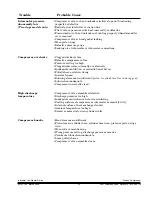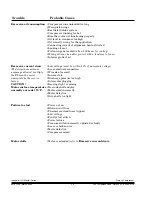
Industrial / Air Master Series
Quincy Compressor
50161-105, March 2008
27
3501 Wismann Lane, Quincy Ill. - 62305-3116
uids.) If lubricant is contaminated, drain and replace.
•Drain receiver tank, drop legs and traps in air distribution system.
Receiver tanks subjected to freezing temperatures may contain ice.
Store the compressor unit in a heated area before attempting to drain
moisture from the tank.
•Give compressor an overall visual inspection and be sure safety guards
are in place.
•Check for any unusual noise or vibration.
•Check for lubricant leaks.
•Check all pressurized components for rust, cracks or leaks. Immedi-
ately discontinue use of the equipment and relieve all system pressure
if any of these problems are discovered. Do not use the equipment until
it has been inspected and repaired by a qualified mechanic.
Every 40 Hours (or Weekly)
•Manually operate the pressure relief valves to be certain they are
working.
•Clean the cooling surfaces of the intercooler, aftercooler and compres-
sor.
•Check the compressor for air leaks.
•Check the compressed air distribution system for leaks.
•Inspect lubricant for contamination & change if necessary.
•Clean or replace the air intake filter. Check more often under humid
or dirty conditions.
Every 160 Hours (or Monthly)
•Check belt tension
Every 500 Hours (or Every 3 Months)
•Change lubricant (more frequently in harsher environments).
•Torque pulley clamp screws or jamnut.
Every 1000 Hours (or Every 6 Months)
•When Quin-
Cip
lubricant is used, lubricant change intervals may be
extended to every 1000 hours or every 6 months, whichever occurs first
(change more frequently in harsher conditions).
•Inspect compressor valves for leakage and/or carbon build-up. If
excessive sludge build-up exists inside the crankcase, clean the inside
of the crankcase as well as the screen.
Never use a flammable or
toxic solvent for cleaning. Always use a safety solvent and
follow the directions provided.
Every 2000 Hours (or Every 12 Months)
•Inspect the pressure switch diaphragm and contacts. Inspect the
contact points in the motor / starter.
Servicing Reed Valves
QT & PLT Series compressor valve plates and reed valves should be inspected
and cleaned on a regular basis. The reed valves are made of stainless steel and
can be cleaned with a stiff bristle brush
(not a wire brush!)
. A clean safety
solvent may also be used to loosen carbon deposits on the valve plates and reed
valves. Handle all parts with care; do not bend, mar or scratch any sealing
surfaces.
Never use gasoline, thinners, or other flammable solutions to clean
valves or related parts.
DANGER !
Summary of Contents for Air Master Series
Page 46: ......
















































